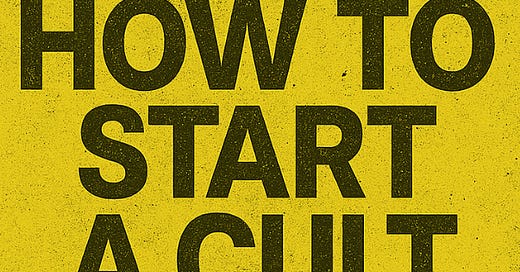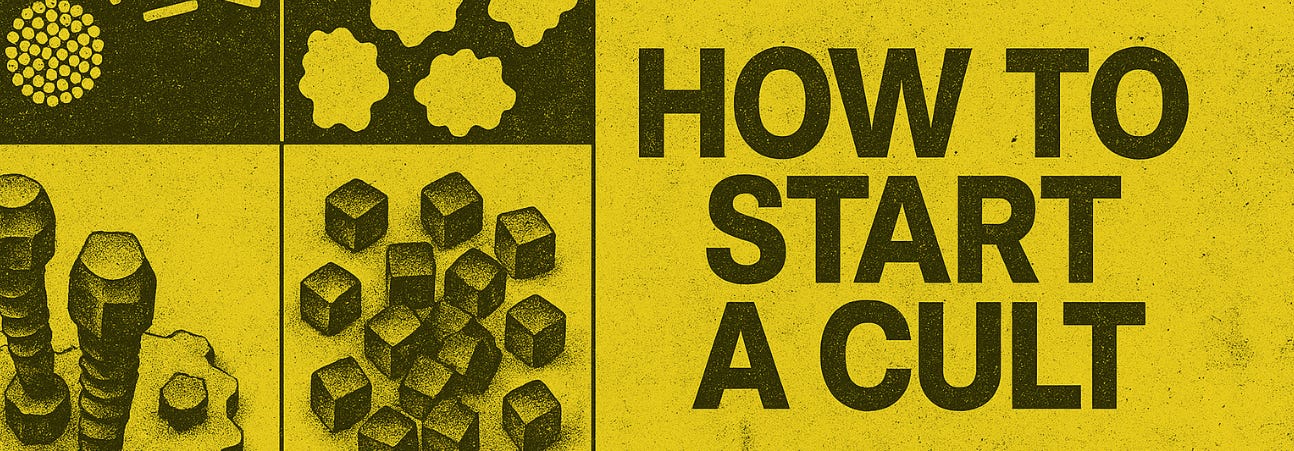How To Start a Cult -
It’s a bloodbath out there. The brands that are surviving aren’t products; they’re full-blown ideologies. Not picking up what I’m putting down? Here’s your cheat sheet:
Tagline should be mantra.
“God first, family second, Mary Kay third.” — Founder of Mary Kay Mary Kay Ash
Audience should be congregation.
“The people who are crazy enough to think they can change the world are the ones who do.” —Steve Jobs
Lifestyle should be ideology.
“Patagonia’s authenticity lies in not being concerned about having an image in the first place.” — Founder of Patagonia Yvon Chouinard, Let My People Go Surfing
Content should be evangelism.
”70 percent of our growth so far has been through owned, earned, peer to peer or organic, because people just fundamentally want to share that they enjoyed their Boy Brow.” — Glossier founder and CEO Emily Weiss
Logo should be symbol.
”The Belo was created as the “universal symbol of belonging. When you see it you will know that you are not alone.” — Airbnb CEO Brian Chesky
Campaign should be mission
“We Don’t Speak January” — 2023 Equinox campaign that led to the highest-grossing January in the company’s history.
The Fall of Consumerism
Consumerism was marketed as the great secular salvation. It promised meaning, identity, and community, all without dogma. But it’s failing.
Why? Because meaning doesn’t scale without belief. And consumerism, in its current form, doesn’t believe in anything but itself.
People are turning to brands to fulfill the very roles that religious, political, and social institutions used to serve. Community, identity, and purpose are now all roles a brand needs to take into consideration for its congregation. There is a marketplace for belief systems, and brands are becoming the primary suppliers.
As sociologist R.M. MacIver put it, "The unity of a group, like all its cultural values, must find symbolic expression. The symbol is at once a means of communication and a common ground of understanding.”
Turning Profit to Prophet
Modern cult brands offer metaphysics, a way to order the world. When someone buys Ben & Jerry’s or Apple, they’re not just consuming but participating in a dialogue. These purchases act as larger expressions.
"Cult brands supply our modern metaphysics, imbuing the world with significance... They are venues for the consumer to publicly enact a distinctive set of beliefs and values"
Cults (and cult brands) rely on meaning systems to bind people together. These systems provide interpretation, purpose, and a sense of control. You can manufacture them, co-opt them from subcultures, or unearth them from within your community.
Gambling Was Rebranded as Scrolling
The psychology behind cult loyalty is the same psychology that drives addiction, and modern platforms know it.
Variable ratio reinforcement, one of the most powerful conditioning tools in behavioral psychology, is the same mechanic that keeps gamblers pulling slot machine levers. It’s also what keeps users scrolling on social media, hoping the next post will deliver a dopamine hit.
Dr. Joseph M. Pierre, a UCLA psychiatrist, analyzed QAnon's gamified structure and found it mimicked gambling and online addiction: a “variable-ratio schedule” of unpredictable rewards, leading to compulsive behavior indistinguishable from addiction.
If you're building a brand and not thinking about conditioning tools and the deeper psychology of your congregation, you're already behind.
Indoctrination by Design
“Indoctrination is what happens during the subsequent process of brainwashing... when the recruit has been successfully separated from external stimuli... then they can begin to be broken down.” — Terror, Love and Brainwashing
Belief isn’t optional. People are always searching for meaning. If they don't find it in religion or politics, they’ll find it in fandoms, crypto projects, fitness apps, or brands. Every time you launch a brand without a doctrine, you’re asking your audience to go elsewhere for belief.
Enter the brand-as-belief-system. Successful modern brands sell a worldview, from CrossFit to Glossier and Supreme to Apple. They codify behavior, generate in-group language, and offer ritualized participation. In its prime, you didn’t just wear Supreme; you were someone who was able to get the drop. You didn’t just use an Apple computer; “You Thought Differently”.
CrossFit turned fitness into liturgy. WODs (Workouts of the Day), Paleo diet codes, and tribal gym affiliations created rituals, doctrine, and dogma.
Glossier built its own glossary. From “Glossier Skin” to “You Look Good,” its customers knew the language, preached it, and posted it without being asked.
Peloton transformed cardio into community. Instructors are treated like spiritual leaders; users refer to themselves as a “family.”
This is known as identity fusion, a psychological state in which personal identity merges with group identity, leading to extreme loyalty and sacrifice. It’s why people tattoo Disney logos. It’s why they’ll line up in the cold for shoe drops. It’s why an update to their favorite brand’s UX feels like a betrayal.
And when belief is structured properly, you don’t need ads.
Want loyalty? Create ritual. Want evangelism? Codify language. Want belonging? Create enemy myths.
Are You Ready to Indoctrinate?
Here are Cult Holdings Co. 6 Pillars of Cult Control, the psychological levers behind every high-devotion brand.
1. Language
Engineered to encode belief, create shorthand, and reinforce in-group logic.
Taglines and phrases adopted as shared affirmations
Memes and cultural remixes as inside joke currency
Fan-generated internal terms (nicknames, acronyms, chants)
Spikes in search interest signal group mindshare
2. Identity
Designed to generate loyalty, participation, and social dependency.
Brand-led communities (Discords, Slack, forums, pods)
Referral behavior as a growth engine
Community-driven knowledge and access
Bios, avatars, merch, tattoos as identity markers
Aesthetic motifs that signal tribal belonging
3. Devotion
Structured mythology around the brand or founder.
Users defend, preach, and police the belief system
Public loyalty becomes personal identity
“Us vs. Them” framing deepens cohesion
Logos and icons serve as belief symbols
4. Rituals
Repeatable actions that solidify identity and behavioral habit.
Daily product rituals (wearing, consuming, checking)
Consistent drop cycles (anticipation → action)
Ongoing content or community touchpoints
Events, livestreams, and timed moments
Shared formats (syncs, group reveals, countdowns)
5. Obsession
Signals of emotional entrenchment and cognitive saturation.
Unprompted UGC and organic mentions
Fan-led remixes, memes, and lore
Repeat consumption (rewatch, reuse, rewear)
Speculation and chatter that occupy mental bandwidth
6. Symbolism
Visual and verbal identity that reinforces belonging.
Iconic logos, colors, marks, and sounds
Brand language repeated across formats
Instantly recognizable POV and style
Fan reproduction (tattoos, stickers, decor, cosplay)
Mimicry by other brands = proof of power
Cult Holdings Co. offers a proprietary Cult Score™ to measure how 'cult' your brand is, versus what it could become.
It's part of our Cult-as-a-Service framework: a strategic system for turning brands into belief systems.
Curious where you stack up? Reach out (Alyssa@bttrhlf.com, for a limited time)









